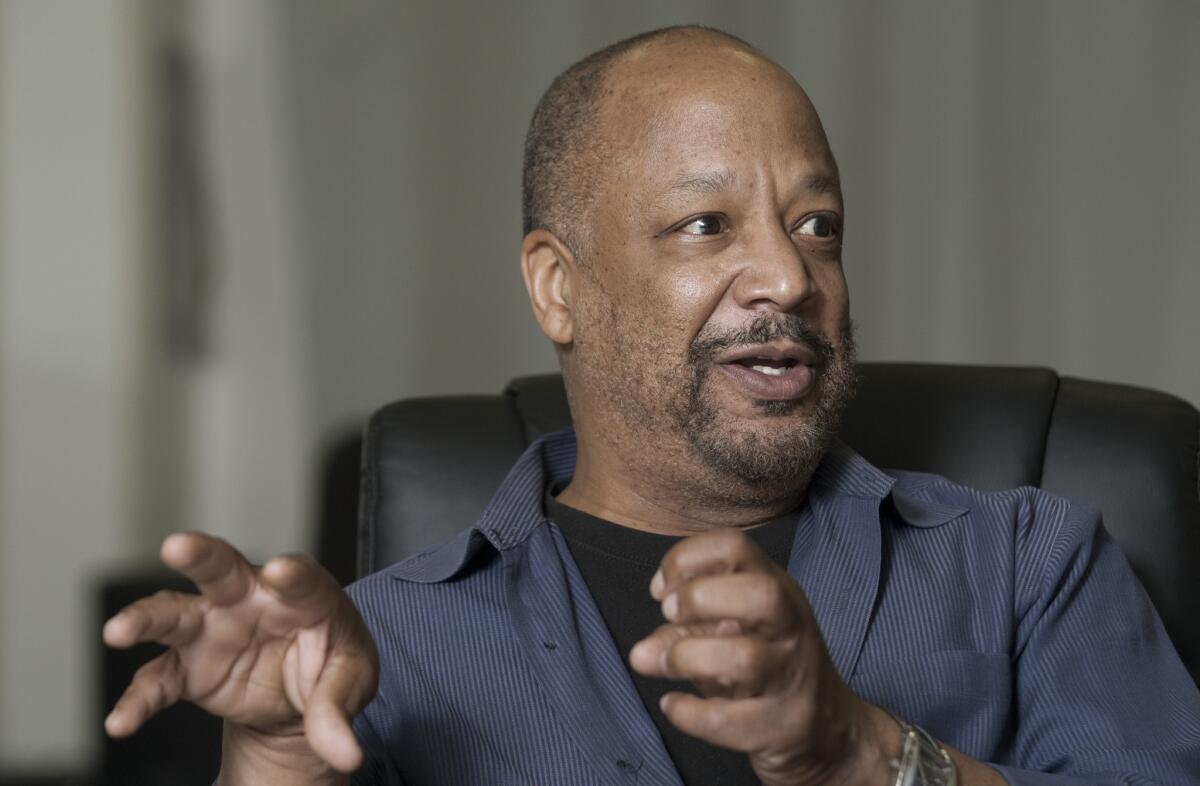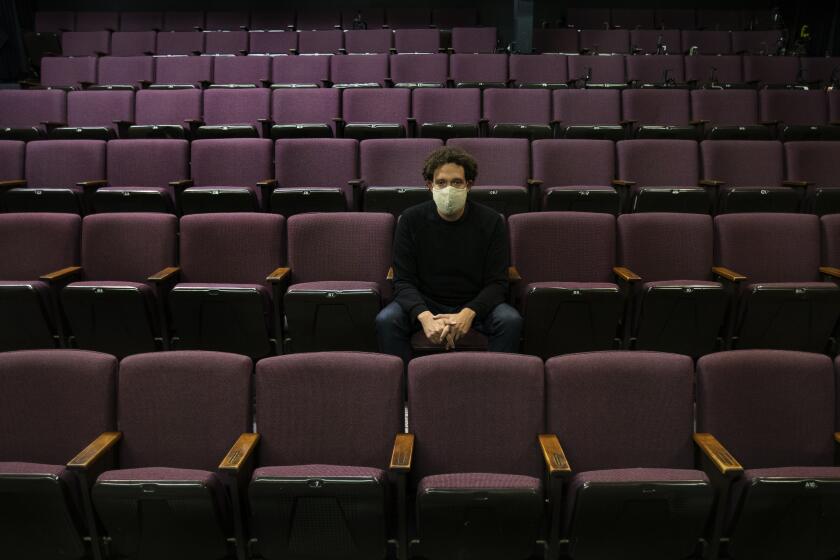How should L.A.’s legacy theaters change after COVID-19? Well, for starters ...

- Share via
Theaters, closed since March and waiting for a public health miracle, have started making announcements about future programming. Exact dates are still a guessing game, but titles are already being publicized.
The choices in some instances are a little deflating. Broadway, in particular, seems willfully stuck in the past. “Our Town” and “American Buffalo” are returning in starry revivals that have all the urgency of syndicated reruns, and a musical adaptation of the NBC backstage series “Smash” is in the works. (Surely, in some producer’s office, the terms of a jukebox version of “The Brady Bunch” are being negotiated.)
Whether our resident theaters — those established nonprofit companies, such as Center Theatre Group, the Geffen Playhouse and Pasadena Playhouse — will ignore the example of the Great White Way and strike out in bold new directions remains to be seen. But CTG’s largest venue, the Ahmanson Theatre, which is set to reopen with Aaron Sorkin’s version of “To Kill a Mockingbird,” is padding its Broadway-heavy season with encore engagements of “Dear Evan Hansen,” “Come From Away” and “Ain’t Too Proud — the Life and Times of the Temptations.”
A new and challenging post-pandemic world looms, but the old business plans haven’t been discarded. As BIPOC (Black, Indigenous and People of Color) theater makers are calling for profound structural change to deal with the institutional racism and widespread inequities in the American theater, the question of whether legacy cultural institutions will have the imagination, boldness and guts to reinvent themselves takes on increased urgency.
The We See You, White American Theater movement has precipitated an overdue reckoning. Steps are being taken to make diversity more than a theme of grant applications. CTG just added Dave Harris’ “Tambo & Bones” to its Kirk Douglas Theatre season, and Jeremy O. Harris’ “Slave Play” is already lined up for the Mark Taper Forum’s upcoming season. On Twitter, a chorus of praise resounded when Roundabout Theatre Company announced it was adding the seldom revived “Trouble in Mind” by the pioneering African American playwright Alice Childress to its future Broadway roster. But much of the news so far has been old news. Artistic leaders, caught been a COVID rock and a hardcore cultural revolution, seem inclined to default to plans that were made before the world turned upside-down.
For those wanting transformation, a crisis is a terrible thing to waste. But will hardship economics allow for new possibilities from our most prominent venues or will it just be a matter of survival for the performing arts? Leaders, coping with budgetary black holes, have a ready excuse for playing it safe. But what if safety lights the path to obsolescence?
Patti LuPone, Lynn Nottage, Tarell Alvin McCraney, Young Jean Lee, Joe Mantello and others answer the question: How should theater be different?
Charles Dillingham, a veteran arts consultant and former managing director of Center Theatre Group who served as interim executive director of Pasadena Playhouse, has a wealth of experience helping nonprofit theaters navigate difficult waters. What makes this crisis unprecedented, he said, is the uncertainty. Not knowing precisely when theaters can reopen has stymied recovery plans.
Large-scale businesses are finding themselves ill equipped to deal with the extent of the shutdown; cultural institutions, not surprisingly, are in rougher shape. Dillingham used the word “precarious” to describe the health of nonprofit theaters before the pandemic.
“I would say they were all under-capitalized, and that’s a big problem,” he said. “Funding has now devolved to almost nothing but individuals of wealth. I think theaters were being buoyed by the Trump Wall Street and the Trump market. But now, who knows? As this pandemic stretches on, the stock market is likely to take another dive.”
The financial outlook for the field? “Cloudy,” Dillingham replied in a stark deadpan. “Small craft warning.”
Given this forecast, is it reasonable to expect the established nonprofit theaters, burdened as they are with significant overhead, to lead the way? An ocean liner may be able to ride out a hurricane, but reversing course isn’t so easy.
Struggling arts venues asked audiences to donate tickets to canceled shows rather than request refunds. But did people do that? Our survey results.
Jon Lawrence Rivera, artistic director and co-founder of Playwrights’ Arena, a company dedicated to the nurturing of Los Angeles playwrights, isn’t taking his cues from the larger venues.
“As a small company, we have never looked at any of the large theaters for leadership,” he said. “I think our programming priorities and financial capabilities are very different. So I tend to look at the innovative practices of my fellow BIPOC artistic leaders for guidance.”
He named Celebration Theatre’s Michael Shepperd, Chance Theater’s Oanh Nguyen and Ophelia’s Jump Productions’ Beatrice Casagran as sources of inspiration. But he acknowledged that he finds “this moment most interesting to witness” through such younger leaders as Jonathan Muñoz-Proulx and Elmira Rahim.
Jessica Kubzansky, artistic director of Boston Court Pasadena, likewise isn’t focused on the moves of the behemoths in town. She’s encouraged by the way this forced suspension of operations has brought the Los Angeles theater community as a whole into closer contact.
“There’s a giant small-theater meeting that gets together weekly,” she said. “Midsize and larger theaters are talking constantly. We at Boston Court are talking often to our neighbors at the Pasadena Playhouse and A Noise Within. Snehal Desai at East West Players and I are talking regularly. One of the weird COVID bonuses is that there is much richer communication among everyone than there has been in the past.”
To meet the unique challenges of this moment, she said, requires everyone to leave the security of their silos. Fresh thinking requires a commitment to openness.
“Because the theater has to be on pause, it should be a time for reinvention, and we should all be trying to find inspiration from anywhere we can — from a theater in Kansas to somebody doing something really innovative not in our field but which can be applied,” she said. “It’s an opportunity to break the box and examine the systemic underpinnings of what’s happening in the American theater. We need to examine the pieces of our culture that are embedded in white supremacy and start to figure out how to break that system and make a better one.”
In their quest to root out systemic obstacles, theater leaders are now examining whether the expectation of agent representation of writers is a barrier to access. Another matter that has come under scrutiny is the tradition of allocating the smallest stage in a large theater complex for marginalized artists — a practice that not only limits their audience but also asks them to do the same work as they would in the larger house for less pay.
For Bill Rauch, the inaugural artistic director of New York’s Ronald O. Perelman Center for the Performing Arts who co-founded Cornerstone Theater Company and was the artistic director of Oregon Shakespeare Festival, “the economic challenges and the demands for profound structural change to address racism and the inequities are not separable. Both are expressions of the profound inequity that has plagued the field for so long and both demand urgent relevance from our institutions.”
The biggest obstacle to progress, in his view, is “the fear of change.” “But the fact is, change is coming,” he said. “Overdue change is coming. To give in to the fear is an enormous, destructive waste of time.”
A self-proclaimed optimist, Rauch has enormous faith in the new generation of leaders of color who have taken the reins of their institutions, among them Long Wharf Theater’s Jacob G. Padrón, Woolly Mammoth’s Maria Manuela Goyanes, Perseverance Theatre’s Leslie Ishii, Baltimore Center Stage’s Stephanie Ybarra and Rauch’s replacement at Oregon Shakespeare Festival, Nataki Garrett.
“I really believe they have the imagination and the courage for the task ahead,” Rauch said. “You need the right leadership team in place with a strong vision rooted in mission. And you need an unwavering commitment to equity. With that in place, any institution can transform.”
Sheldon Epps, former artistic director of Pasadena Playhouse, pulled off such a transformation. Speaking by phone, he recalled that when he first arrived at the Playhouse he would sit in the courtyard before a show and feel like he was “one of the few people under 60 and the only person of any color” in attendance. By the end of his tenure, some of the theater’s biggest successes were productions of works by African American artists, cheered on by an audience that more closely resembled the diversity of Los Angeles.
“There is no doubt that this is one of the most challenging times in the history of the American theater,” Epps said. “But for me the wise way for an artistic leader to think of this is as an opportunity to re-create the American theater. We have been living with the model of resident theater companies established by people like Gordon Davidson, Zelda Fichandler and Nina Vance for more than 50 years. What we forget is that when those people started, they didn’t have a model. They created a model, and I think we have the opportunity to do that now.”
Epps would like to see a complete restructuring: “It’s a time for us to get rid of the schedules, the timing of productions that we were formerly stuck with, and it’s an opportunity to get out of the building and to define places to make theater rather than do what we have always assumed, which is to make theater inside the buildings we run.”
Funding sources also need to be looked at more critically, and that includes long-term subscribers. When asked to identify a major obstacle to institutional change, Rivera said “theaters trying to serve their older patrons.” (“To make changes that really matter, you have to do them fearlessly,” he added.)
One such change might involve prioritizing community outreach over fundraising. As the subscription model has dwindled along with corporate and public support, galas for wealthy donors have gone into overdrive. Perhaps some of that institutional muscle could be redirected in a grassroots effort to expand the pool of theatergoers.
More inclusive programming, in addition to being ethically right, has the potential to grow the audience base. Epps said that his argument for diversity was not only “emotional and aesthetic but also economic,” based on the assumption that a more diverse audiences would come if work were being made for them and they were told about it.
“Because we were doing that so early and before so many other theaters, I had no proof,” he said. “But I certainly stood by that theory and fortunately it proved to be true very, very quickly, otherwise I probably would have been run out of town. I always said it was hard for the board to argue with success, because many of those shows with a built-in African American audience became some of the highest selling shows in the history of the theater. Did it shake up some of the longtime subscribers and audiences who had been coming to Pasadena Playhouse for years? Yes, absolutely. Most people loved the diversity. Those who did not and who were simply not interested in seeing those plays, I rather gratefully accepted that they were going to go away. We lost a few, but the loss was nowhere near the gain.”
Pasadena Playhouse went through a period of bankruptcy, but diversity has been a source of renewal for the theater. Cultivating local audiences with a passionate interest in plays isn’t for the faint of heart. Few have been able to crack the code of attracting the younger demographic, which is inherently more diverse.
But building a bigger tent while maintaining a high level of artistic quality, as producing artistic director Danny Feldman has managed since he took over Pasadena Playhouse, at least provides a fighting chance. (One of the biggest hits in the Playhouse’s history was last year’s modern take on “Little Shop of Horrors” with Mj Rodriguez.) The business of theater is still impossible, but the economic excuse for maintaining the status quo is a losing game.
“In a time of change, I think any and every change can be approached more easily,” Epps said. “There are no rules right now. There’s a national call for American theaters to reflect what America is, and I think any theater that doesn’t do that is doomed.”
Interviews with more than a dozen BIPOC performers and staff at the Groundlings and UCB reveal systemic problems within L.A.’s sketch and improv world.
More to Read
The biggest entertainment stories
Get our big stories about Hollywood, film, television, music, arts, culture and more right in your inbox as soon as they publish.
You may occasionally receive promotional content from the Los Angeles Times.














